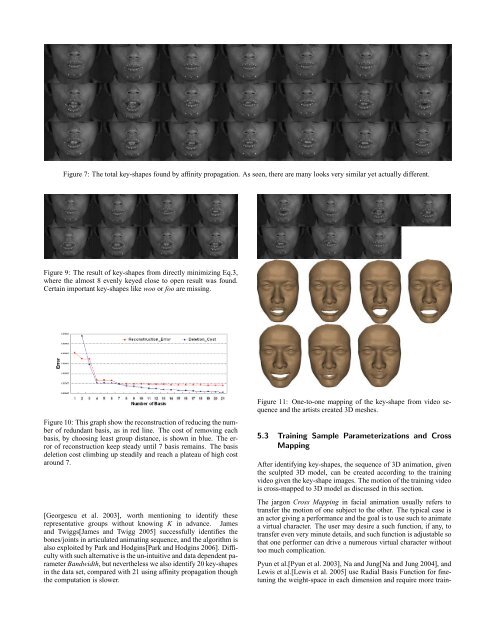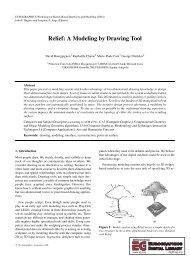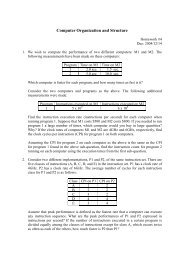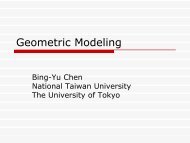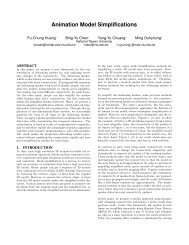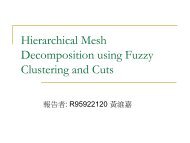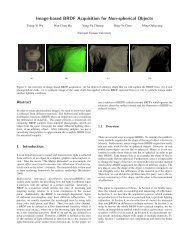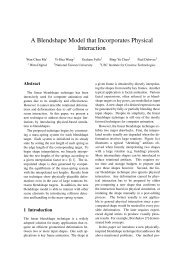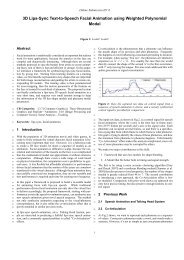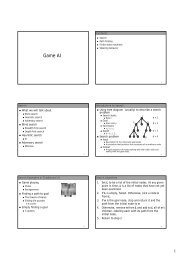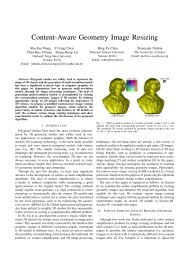Figure 7: The total key-shapes found by affinity propagation. As seen, there are many looks very similar yet actually different.Figure 9: The result of key-shapes from directly minimizing Eq.3,where the almost 8 evenly keyed close to open result was found.Certain important key-shapes like woo or foo are missing.Figure 10: This graph show the reconstruction of reducing the numberof redundant basis, as in red line. The cost of removing eachbasis, by choosing least group distance, is shown in blue. The errorof reconstruction keep steady until 7 basis remains. The basisdeletion cost climbing up steadily and reach a plateau of high costaround 7.[Georgescu et al. 2003], worth mentioning to identify theserepresentative groups without knowing K in advance. Jamesand Twiggs[James and Twigg 2005] successfully identifies thebones/joints in articulated animating sequence, and the algorithm isalso exploited by Park and Hodgins[Park and Hodgins 2006]. Difficultywith such alternative is the un-intuitive and data dependent parameterBandwidth, but nevertheless we also identify 20 key-shapesin the data set, compared with 21 <strong>using</strong> affinity propagation thoughthe computation is slower.Figure 11: One-to-one mapping of the key-shape from video sequenceand the artists created <strong>3D</strong> meshes.5.3 Training Sample Parameterizations and CrossMappingAfter identifying key-shapes, the sequence of <strong>3D</strong> animation, giventhe sculpted <strong>3D</strong> model, can be created according to the trainingvideo given the key-shape images. The motion of the training videois cross-mapped to <strong>3D</strong> model as discussed in this section.The jargon Cross Mapping in facial animation usually refers totransfer the motion of one subject to the other. The typical case isan actor giving a performance and the goal is to use such to animatea virtual character. The user may desire a such function, if any, totransfer even very minute details, and such function is adjustable sothat one performer can drive a numerous virtual character withouttoo much complication.Pyun et al.[Pyun et al. 2003], Na and Jung[Na and Jung 2004], andLewis et al.[Lewis et al. 2005] use Radial Basis Function for finetuningthe weight-space in each dimension and require more train-
ing samples to explore the function form. Buck et al.[Buck et al.2000] use convex hull technique that each training faces is project toa plane, with three nearest key-shapes, the barycentric coordinatesare obtainable and transferred to NPR faces for rendering. Chuangand Bregler[Chuang and Bregler 2002] propose a cross mapping algorithmmost representing ours, yet the parameterized weights aredirectly used to linearly interpolate <strong>3D</strong> models.The goal in this paper is that the performer utters some words, andthe sculpted <strong>3D</strong> models should be interpolated in a way as if itspeaks.Given the key-shape lips images S = {S 1 ,...,S K } and its corresponding<strong>3D</strong> models P = {P 1 ,...,P K }, a sequence of <strong>3D</strong> facialanimation can be built based on the original video sequence F ={ f 1 ,..., f n }. <strong>Key</strong> ideas are to parameterize video sequence <strong>using</strong>S into W = {w 1 ,...w 18000 } ∈ R K , transfer the coefficients to <strong>3D</strong>model space, and use the coefficients and P to construct the correspondingsequence.The first is to parameterize video sequence from image space intoweight space W <strong>using</strong> S, and is formulated as:Kmin‖ f j −∑S i w ji ‖ 2 , ∀ f j ∈ F (4)iThe solution of this minimization is straight forward and a standardlinear least square solver can apply. The obtained weight, thoughbest fit for least error reconstruction, is not suitable for further editingand transfer. One important reason is over-fitting that whenminimizing error, some weights will be much larger and others haveto be negative to counter balance. If weight transfer is desirablethen large or negative weight should be avoided. A non-negativeleast square (NNLS)[Lawson and Hanson 1974] solver is efficientand available that solve the following constrained minimization:Kmin‖ f j −∑S i w ji ‖ 2 , ∀w ji ≥ 0, ∀ f j ∈ F (5)iThe weight W can be directly used as α in Eq 2. Such direct transferwill, however, introduce an un-pleasing result because the nonlinearitynature of projection as we introduce in Fig. 12. The observedfeature points undergoes a projection that maps a constantangular movement to a cosine function, and while uniformly sampledon the angular space, the projection will result in a seeminglyclustered sampled at degree 0. This non-linearity phenomenon istypically modeled <strong>using</strong> RBF, yet another alternative is proposed tomodel this projection.One feasible solution is to select the corresponding features on the<strong>3D</strong> model, blend them <strong>using</strong> W in the projection plane, i.e., x and ycomponent only, and use these transferred projected points as constraintsto plug in Eq.1 solving for α. Thus the result of <strong>3D</strong> animationis α = {α 1 ,...α 18000 } defining the cross-mapped reconstructionparameters. Two primary reasons <strong>using</strong> the technique fromSumner et al.[Sumner et al. 2005] are the following:1. Since the observation is two dimensional images, and by assumingfake orthogonal projection, the prior from examplesand exponential-map provides fairly acceptable result whenonly two, rather than three, dimensional constraints are specified.2. The use of exponential-map provides linearity that is usefulfor density estimation and multi-linear analysis. Take Fig. 12for example: When the angular speed is constant, samples onangular space is uniform from {0... 2 π }, yet when projected,over 3 2 , i.e. 60 degree, of samples are between {0,..., 2 1 } andleading a false density estimation.The non-linear cross-mapping function <strong>using</strong> exponential-mapgives an alternatives for mapping motion from one subject to another,while providing physical meaning of projection. Result of the<strong>3D</strong> animation corresponds to the training video can subsequentlyused for estimating the probabilistic model phonemes.5.4 Phoneme Space Construction and TrajectorySynthesisAfter cross mapping a sequence of α = {α 1 ,...,α 18000 } associatewith phoneme tag on each frame, the statistical analysis forphoneme set Φ = {Ph 1 ,Ph 2 ,...,Ph 51 } can be performed for densityestimation:α jµ Phi =∑ , Σj N Phii=∑j(α j − µ Phi )(α j − µ Phi ) TN i, ∀α j → tag = Ph iwhere N i is the number of training frame that correspond to thephoneme Ph i , and the density is modeled with multi-dimensionalGaussian:√1p µPhi ,Σ Phi(X) =(2π) K ‖Σ‖ exp{− 1 2 (X − µ)T Σ −1 (X − µ)}Meanwhile, any speech {ph 1 ,..., ph T },∀ph t ∈ Φ of length T tagscan be synthesized with a sequence of x = {α 1 ,...,α T } by the minimizingthe following objective error function E consists of a dataterm and a smoothness term:E = (x − µ) T D T Σ −1 D(x − µ)+λx T W T Wx (6)Figure 12: The projected point position x is the function of cos(θ),so the constant angular speed ω will result in a sine function, rathera constant speed for x.The data term is a measurement of normalized distance from eachphoneme distribution center, and the smooth term prevent the pathfrom being changing too excessively. In the objective function, xis a vertical concatenation of individual α t at time stamp t, µ constructedfrom phoneme center that the speech is about to pass, and Σfrom diagonal phoneme covariance, assuming independent in eachdimension without loss of generality.


